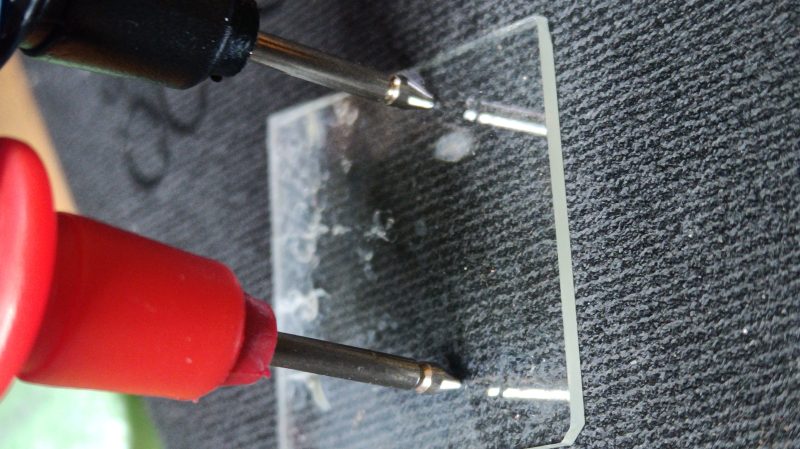Glass! It’s, uh, not very conductive. And sometimes we like that! But other times, we want glass to be conductive. In that case, you might want to give the glass a very fine coating of tin oxide. [Vik Olliver] has been working on just that, in hopes he can make a conductive spot on a glass printing bed in order to use it with a conductive probe.
[Vik’s] first attempt involved using tin chloride, produced by dissolving some tin in a beaker of hydrochloric acid. A droplet of this fluid was then dropped on a glass slide that was heated with a blowtorch. The result was a big ugly white splotch. Not at all tidy, but it did create a conductive layer on the glass. Just a thick, messy one. Further attempts refined the methodology, and [Vik] was eventually able to coat a 1″ square with a reasonably clear coating that measured an edge-to-edge resistance around 8 megaohms.
If you’re aware of better, easier, ways to put a conductive coating on glass, share them below! We’ve seen similar DIY attempts at this before, too. If you’ve been cooking up your own interesting home chemistry experiments (safely!?) do let us know!
















Silver. It’s much more conductive than tin and can be deposited in transparent films as well.
Yes, it’s more expensive but in the miniscule amounts we’re talking that’s not really a factor.
Good call. It doesn’t say in the article if the glass has to be transparent after the coating is applied. If not, silvered glass has been around for a while as mirrors. Although I assume they don’t actually use Ag any more.
Most modern mirrors are aluminium. Sliver is still used because it’s easier to do, aluminium is done by sputtering (aka vacuum deposition) whereas silver is just sprayed on.
You spray silver chloride or silver nitrate or whatever (I forget) onto glass and evaporate off the “not silver” stuff.
Telescope mirrors tend not to use silver because it tarnishes easily, they were usually aluminium and expensive back when sputtering wasn’t cheap. Silver is shinier though. Really old ones were tin coated.
You occasionally find odd stuff like rhodium or titanium, and low power lasers use gold mirrors because they’re good for IR (not great because they are easily damaged).
Higher power lasers use primary mirrors, different surface materials for different wavelengths of cause.
I would just stick on a small square of aluminum duct tape (the real stuff, with high temp adhesive), then account for the thickness of the tape.
LowE glass is conductive
Use regular glass and just turn the probe voltage up.
Blocks rf as well!
It looks like resistance is being measured between probe tips. If so, most of the resistance is going to be in the region of the probes, not the large area of the film. Perhaps dots or stripes of conductive epoxy as contacts would produce more impressive results.
The conventional clear conductive film is indium tin oxide. Doping tin oxide with fluorine or antimony are other approaches. See the wikipedia articles on indium tin oxide and tin(IV) oxide.
If I had to invisibly get electricity across glass, I’d be tempted to try carbon. If I wanted to do it dependably and didn’t really need a film, I’d glue down fine copper wire. AWG 44 is available from Digikey and AWG 56 from Alibaba.
But… Why?
If it’s a printing plate, surely the surface being glass is the important part right? Adding an oxide layer means you aren’t printing on glass anymore.
And if it doesn’t matter, then why go through the trouble in the first place instead of just using a plate surface that is already conducive, which probably has better mechanical properties?
This seems like a pretty extreme case of the X Y problem in action.
Read the article again. It’s only a square inch on each corner. As for why, I assume the idea intrigued him. There is several easier ways to do it, but sometimes you do something in a weird way to learn and entertain yourself.
People home brewing electrostatic speakers rub carbon graphite on.. mylar I believe… to give it some conductivity for use as the driven element. I think literally with a cotton ball- just rub it on.
Wow, thanks for that. Until now I had no idea people could build their own electrostatic speakers. I used to drool over the Quad electrostatic speakers advertised in my dad’s UK electronics magazines from the 1960s, wondering how they could get them so elegantly thin compared to a traditional hifi speaker enclosure. I recall they were not at all cheap!
That is prototype production grapgene
I’ll just point out that one side of your window glass already has a tin oxide coating. Float glass is made from floating molten glass on a pool of molten tin, and some of that tin sticks. It’s not much, but it is there.
Interesting enough the tin side is smoother than the other side.
Ben Krasnow on his Applied Science youtube channel managed to atomically deposit copper onto glass by sputtering, well worth watching as is all of his videos.
Gold leaf is conductive, very thin (0.1-0.2 microns!), sticks to glass, and not very expensive. Not terribly transparent, however.
ITO coatings are already available for home use, e.g. Zypcoat ITO, lumilor CTC, etc.
Indium has a very low boiling point. Indium oxide is the most conductive oxide (when doped with 10% tin). I wonder, could someone use a blowtorch in ambient conditions to sputter a thin layer of indium onto the surface of glass? It wouldn’t be a uniform layer, and it may cause optical interference, and it’s much more expensive than silver, but it would be easy and transparent and highly conductive (on par with metallics).